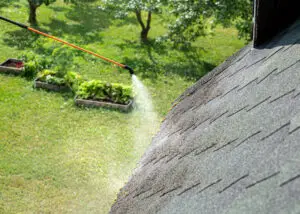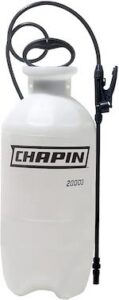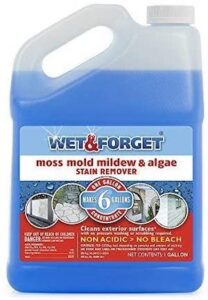Have you begun to notice some streaky discoloration on your roof? Or maybe even some green, mossy stains that seem to have come from nowhere? Maybe it even looks dark, like someone’s been rubbing charcoal over your home’s roof! You’re probably dealing with mold or algae that has started to creep onto your roof’s surface. Usually, homeowners will begin to notice the marks after two or three months, as the algae continues to worsen and become more prominent?
How do I remove Algae from Roof Shingles? Washing your roof with a powerful roof cleanser will do the trick. In this process you will want to use water and bleach to cleanse your roof. Below, we will delve more into what to do if algae has become apparent on your home’s roof.
How to Identify Algae on My Roof
While algae can be found on all roofs types, it’s often drawn to asphalt shingles. Asphalt shingles are pretty common to use since they are less expensive. These types of shingles are generally mixed with crushed limestone and fiberglass with asphalt to make the shingle. The crushed limestone, in particular, is a common food source for mold or algae and the main reason why it may be more likely to show up on asphalt roof shingles.
Some signs that you are dealing with an algae infestation are:
- An Odor: Growing mold often gives off a gross, musty odor. Even if there are no visible signs of decay, a musty smell is a tell-tale sign of mold lurking nearby.
- A Leaky Roof: If that smell that we mentioned is coming from your attic, then it’s probably a problem relating to mold on your roof. If you have a leaky roof, the chance of decay gets even higher. Many things can cause a leak, but the main problem is that it lets moisture get to wood materials. This causes wood rot and mold growth.
- Dark Streaks: Mold often will appear like streaks of dirt. The color can range from black, brown, and green.
- White, Thread-Like Streaks: White mold may also emerge on your roof. Although it can be hard to see, keep an eye out for unusual white streaks.
- Small Dark Dots: White mold can also appear as small dark dots. Again, you should occasionally check your roof closely for these.
While there are many approaches to ridding your roof of algae, most aren’t as easy as they promise. Although you might read to use a power washer, that isn’t a method we recommend since high-pressure power washers could potentially harm your shingles even more. Another technique that’s commonplace on the internet is to use bleach to clean your roof. This may kill the visible layer of algae and make your roof appear clean, but it might not get rid of all the algae, allowing it to grow back very quickly.
 How to Get Rid of Algae on My Roof Shingles:
How to Get Rid of Algae on My Roof Shingles:
Here are a few steps to take in getting rid of algae so it doesn’t return.
1) Gather the Proper Tools:
Pump-up Garden Sprayer
Wet & Forget Algae Cleaner
Rinse with Garden Hose
2) Saturate the Shingles with Wet & Forget
You will start the process by saturating the shingles with the roof cleaner. The biodegradable cleaner is a unique and effective way to clean any exterior surface. Upon application is will attack algae while protecting the integrity of your roof, getting rid of stains without harming it in any way! You can apply it once it has been diluted with water. The gentle cleaning action of a gentle cleaner will remove even the most stubborn stains. It doesn’t require scrubbing, rinsing or harmful acids to clean your roof shingles. It’s also safe for your skin too! It takes time depending on how much algae is present on your shingles. I may multiple applications but should be able to see initial results within 30 minutes – 1 hour
3) Rinse With Garden Hose
You’ll wash it off with the water from your garden hose and repeat the process until the algae has all dispersed. Go slowly and use even strokes when washing the shingles clean. If the garden hose is not powerful enough, you’ll want to invest in something more powerful or hire a professional to do the cleaning for you.
How Often Should I Clean the Algae Off of My Roof?
Algae can drastically affect your house’s overall appearance, and the longer the mold or algae is on your rooftop, the more it will grow. Your roof will need to be cleaned every few years to ensure that mold or algae do not creep back up. If you have the equipment and your comfortable cleaning your roof yourself, this is a good option. However, if your roof slope is too steep or you don’t have the proper equipment, then it might be worth it to invest in hiring professionals to clean your roof every few years.
That’s why we recommend lye soap and a cleanser that is made for roofs. That way, you get rid of all the mold without harming your roof’s shingles. Always look for safe and non-corrosive cleaners when you’re thinking about washing your roof (or anything else for that matter). We want you and your home to be as safe and clean as possible, without compromising on either one.
When is the Best Time to Clean My Roof?
Another tip for washing your roof free of algae is to double-check the day you plan to execute. Verify the weather prediction and pick a moderate or overcast day with minimal wind. The less wind, the better to not accidentally spray the cleaners onto the rest of your house or a neighbors yard. A cool and overcast day is best for the algae to soak up the cleansers best and properly cleaned off for the roof.
Be sure that any loose shingles or broken gutters have been cleaned. We don’t want anything to go wrong when it comes time to clean your roof. Although we recommend using a safe and non-corrosive cleaner, there will undoubtedly be run-off from the roof washing. You’ll want to move any lawn furniture or cover anything that cannot be moved and might get in the way of the run-off. Since mold and algae will be coming off the roof, you’ll want to be sure it doesn’t land on any patio furniture or an outdoor kitchen area. The run off will also make your lawn wet and damp and it may take some time for it to dry out.
Why Is there Algae on my Roof?
There are various causes for algae to begin growing on your roof. It often favors warmer and more humid climates, so if you live somewhere that fits that description, you’re more likely to deal with roof mold. While roof algae can happen just about anywhere in the U.S., most cases are seen in the warmer, Southeast regions: Mississippi, Tennessee, Alabama, Georgia, Florida, Louisiana, North and South Carolina, and Arkansas.
Roofing materials can also play a significant role in the cause of roof algae production. While algae and mildew tend to be attracted to homes in the warmer climates, algae prefers a house whose roof is shaded and sometimes exposed to cooler and wetter weather. Although attracted to opposite environments, both moss and mold are pests that you’ll want to get rid of as soon as possible when it comes to your home. If your climate can get reasonably wet, we recommend that you especially check the north side of your roof. Usually, the Northside receives less sun, and algae is more likely to be there.
Algae is an unfortunate issue to have for your homes’ roof. It can cause roofing to be replaced sooner, draw rodents, damage your attic, and potentially travel to the rest of your home. Algae is a problem you will want to take care of ASAP before it leads to other issues.
If you’re wondering how to prevent the ugly mold streaks from appearing in the future, we have a few tricks up our sleeves. You can install a zinc or copper strip (about 6-inches wide) under the shingling nearest to the roof peak. The water running off this metal during rain will kill any algae trying to live in your shingles and is an excellent deterrent for mold. If you choose shingles with copper granules, this will also be a mold and algae deterrent. Some other options are out there when it comes to keeping mold and algae away, but that’s our main recomendation. Algae and mildew on your roof can be a nuisance and lower the value of your home overall, so be sure to invest some time or money into the health of your roof. It will pay off in the long run and improve the safety and appearance of your house. Although there are many options out there, remember that when you’re in doubt about mold or algae on your rough, it’s best to call a professional to take a look.


